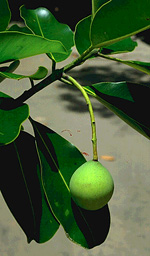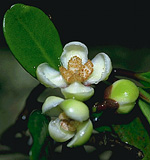 |
This family is essentially tropical, although Hypericum is a large temperate genus. Similarly, most members of the family in Australia are rain forest trees of Queensland, but Hypericum are herbs mostly of temperate regions and includes both native and weedy species.
Characteristic features of the family Clusiaceae in Australia include: - trees, shrubs or (Hypericum) herbs, with coloured sap in stems, leaves and flowers sometimes secreted as granular crystals
- leaves opposite, simple, entire
- petals free, 4 or 5, yellow or white
- stamens numerous, usually in bundles
- ovary superior, developing into a capsule, berry or drupe
Description
Evergreen trees, shrubs, or annual or perennial terrestrial herbs. If herbs then perennating by rhizomes, stolons or taproots. Vegetative reproduction absent or by rhizomes, stolons or root suckers. Stem internodes terete, strongly flattened or distinctly angular. Internal secretions of coloured sap. Plants glabrous or with simple, dendritic or stellate, non-glandular, unicellular or uniseriate hairs. Leaves opposite, cauline if herbs, petiolate or sessile. Stipules absent. Lamina simple, symmetric, filiform, acicular, subulate, linear, lanceolate, ovate, elliptic, oblanceolate, ovate, oblong or orbicular; base cuneate, attenuate, rounded, cordate or lobed or auriculate; margins entire, ±flat, revolute, recurved, involute or incurved; venation pinnate, with the midrib conspicuous, and the tertiary venation reticulate or not; surfaces dark-punctate or not punctate; herbaceous. Male and female flowers occurring on separate plants, or bisexual flowers and both male and female flowers occurring on the same plant, or with all the flowers bisexual. Inflorescences terminal or axillary, consisting of racemes, panicles, cymes, corymbs, umbels or solitary flowers. Bracts present or absent. Bracteoles present. Pollination by insects (?coleoptera). Flowers odourless or fragrant; stalked. Floral disc absent; nectaries absent or present on the perianth. Perianth regular, of 2 dissimilar whorls, or of 1 whorl only, or all whorls ±similar. Calyx segments free or fused, with 2–10 sepals or lobes, imbricate or valvate in bud; calyx cup-shaped, succulent or papery. Corolla segments free, with (2–) 3–6 (–14) petals, alternating with the sepals or lobes, imbricate in bud; corolla white, cream, yellow, orange, green, grey, brown or black, without contrasting markings, membranous, papery or succulent; claws absent; lobes ±entire. Fertile stamens numerous, not clearly correlated with the sepals or calyx lobes, free or at least partly fused to the corolla, free of the ovary and style or at least partly fused with the ovary or style, distinct from each other, or grouped or fused into bundles or fused by their filaments into an open or closed tube, all ±equal. Staminodes present or absent. Anthers dorsifixed or basifixed, not versatile, opening outwards by longitudinal slits; 2-celled. Ovary superior and sessile. Carpels 2–5 (–13), fused; ovary with 1–5 locules. Style terminal, single and unbranched, or branched above or from the base. Ovules 1–numerous per locule, stalked or rarely sessile; placentation basal, parietal or axile. Fruit a dry, dehiscent septicidal or loculicidal capsule or a fleshy indehiscent berry or drupe; the perianth on the maturing fruit deciduous or dry and persistent. Disseminule micro-surface ±smooth, tuberculate, colliculate or rugose, yellow, brown or black, dull. Seeds 1–numerous per fruit. Aril present or absent. Cotyledons 2. Embryo straight or curved.
(Note: this description has been generated from the coded data compiled for the key. Any errors in the key data will be reflected in the descriptions.)
A treatment of the family Clusiaceae has not yet been published in the Flora of Australia. It will appear in Volume 6.
Australian genera of Clusiaceae (as recognised for the Flora of Australia)
† = some species native, others introduced
Calophyllum
Garcinia
Harungana
†Hypericum
Mammea
Mesua

|
  |

Calophyllum inophyllum (flowers)
Photo: H.Nicholson © H. & N. Nicholson

Calophyllum inophyllum (fruit)
Photo: G.Leiper © G.Leiper

Calophyllum sil (fruits)
Photo: G.Sankowski © Zodiac Publications

Garcinia brassii (flowers)
Photo: H.Nicholson © H. & N. Nicholson

|

| |